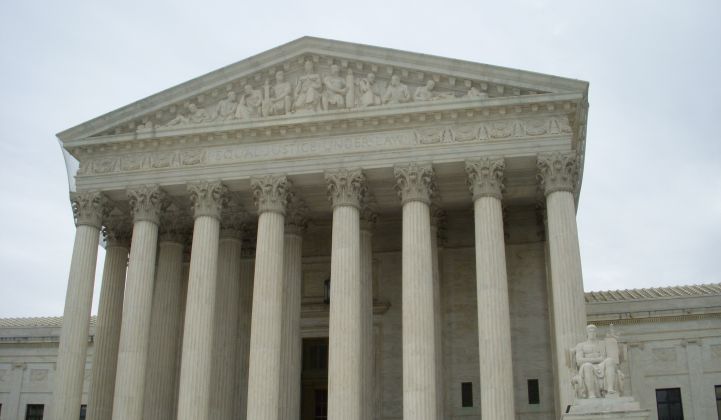The U.S. federal government took a snow day on Monday. But the U.S. Supreme Court soldiered on, delivering its decision in the case of Federal Energy Regulatory Commission vs. Electric Power Supply Association.
In a 6-2 decision, the Supreme Court struck down a lower court opinion and ruled that the Federal Energy Regulatory Commission (FERC) has the authority to regulate demand response.
FERC appealed to the Supreme Court in 2014 to reverse a lower court ruling that vacated its Order 745, which calls for demand response to be compensated like other generators in wholesale energy markets.
Justice Elena Kagan wrote the majority opinion, with Justice Antonin Scalia filing the dissenting opinion along with Justice Clarence Thomas. Justice Samuel Alito abstained.
The court ruled on two separate issues. The more significant issue was whether FERC has the authority to regulate demand-response participation in interstate wholesale markets.
FERC’s Order 745, approved in 2012, calls for grid operators to pay the full market price, known as the locational marginal price (LMP), to economic demand-response resources in real-time and day-ahead markets as long as the resource is cost-effective. Economic demand response is a very small portion of the market compared to demand response in the capacity market.
“FERC has the authority -- and, indeed, the duty -- to ensure that rules or practices 'affecting' wholesale rates are just and reasonable,” wrote Justice Kagan. “Taken for all it is worth, that statutory grant could extend FERC’s power to some surprising places.” The court concluded that demand response fell squarely within FERC’s regulatory scope under the Federal Power Act.
“If rewarded at LMP, rather than at some lesser amount, more demand response providers will enter more bids capable of displacing generation, thus necessarily lowering wholesale electricity prices,” the majority opinion added.
Jon Wellinghoff, former FERC chairman who led the agency when Order 745 was created, was always confident FERC would win at the Supreme Court. He said Monday’s decision paves the way for far more resources of all sizes to play in wholesale markets.
“It will have a tremendous impact on consumers to control their energy cost and provide a service to the wholesale market,” said Wellinghoff. “It’s going to make consumers an equal participant in the market in a way they never were before. That was the intention of Order 745, and that has been vindicated.”
The second and lesser issue was whether FERC has the authority to regulate the rules on what markets will pay for demand-response resources.
On that point -- which many in the industry were unsure about -- the court also sided with the federal regulator.
“Our decisions uniformly speak about rates, for electricity and all else, in only their most prosaic, garden-variety sense,” Kagan wrote. “The commission, not this or any other court, regulates electricity rates.”
The majority opinion ruled that FERC had done its due diligence in setting the rate for economic demand response, but acknowledged that it is a technical issue where both sides of the compensation issue have some merit.
“We do not discount the cogency of EPSA’s arguments in favor of LMP-G. Nor do we say that in opting for LMP instead, FERC made the better call,” wrote Kagan.
Even though EPSA had compelling points in its argument that demand response should be paid the LMP minus generation, the court found its argument flawed. Demand response has to be regulated by some entity, and EPSA’s reasoning could have left the resource in regulatory limbo.
“The upshot of EPSA’s view would be to extinguish the wholesale demand response program in its entirety,” the court concluded.
Some generators want to dismantle demand response entirely. A decision by the Supreme Court against FERC’s jurisdiction would have threatened capacity markets, a much larger portion of the demand response market.
After the lower court ruling in 2014, FirstEnergy filed a complaint with FERC demanding that it force PJM to do away with demand response as a resource altogether.
“It certainly gives them a blow,” said Katherine Hamilton, executive director of Advanced Energy Management Alliance, of FirstEnergy's campaign.
Wellinghoff did not mince words: “It totally shuts down FirstEnergy,” he said. “That complaint no longer has any validity.”
The decision by the Supreme Court on jurisdiction is a setback to entities that are fighting against demand response because they contend it erodes profit margins of traditional generators.
In many states, however, demand-side resources have become as important as generation. California, which has its own independent system operator, has been testing out new rules and regulations for incentivizing distributed energy resources, including demand response.
New York, also with its own independent system operator, is looking at new business models that value demand-side resources like demand response.
The decision is not just a win for large-scale demand response, said Wellinghoff, but also for resources at the edge of the grid like solar and energy storage. “Consumers can fully play in wholesale markets like a generator,” he said. “I think it will be a very positive thing for all types of resources.”



